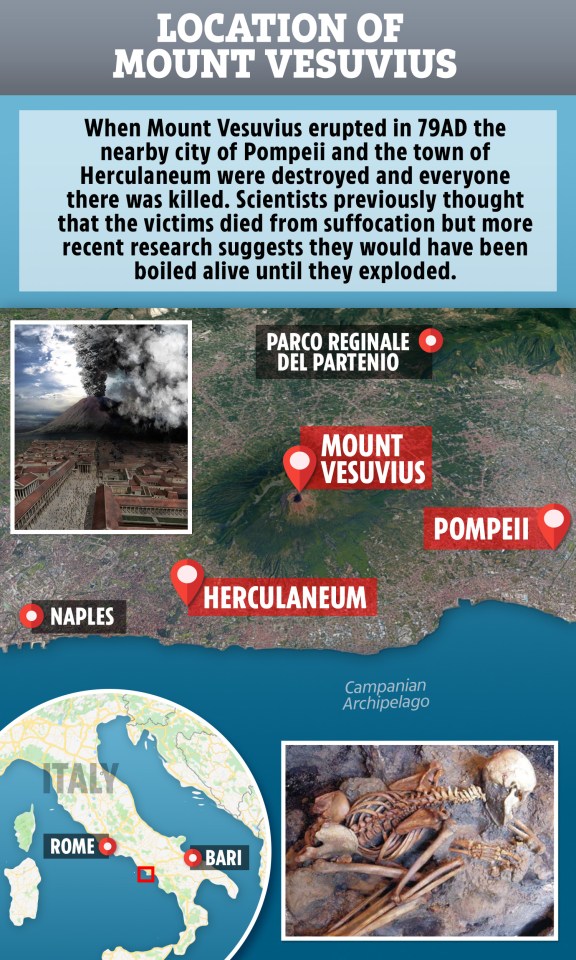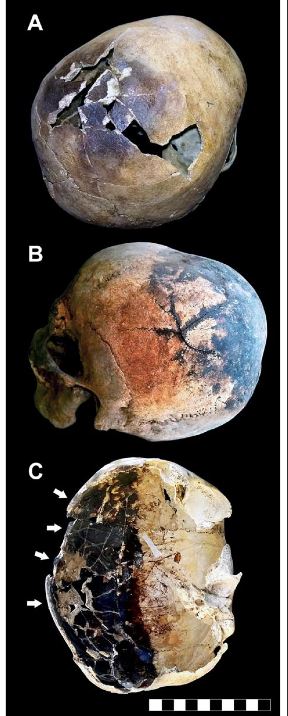Vesuvius eruption was so hot it turned a man’s brain to GLASS during destruction of Pompeii

HEAT from the 79 AD eruption of Mount Vesuvius was so extreme that it turned one victim's brain into glass.
The man, who was about 25 when he died, was found lying face-down on a wooden bed – and may have been asleep when disaster struck.
Vesuvius' eruption is best known for destroying the ancient Roman city of Pompeii.
But it also wreaked havoc in nearby Herculaneum, a wealthy town buried by super-heated ash.
In a surprising first, experts have found remains of human brain tissue that was vitrified – or turned into glass.
It's a remarkable discovery, because brain tissue typically decays completely or turns into a soapy substance.
Temperatures must have been especially high to cause such an effect.
"This suggests that extreme radiant heat was able to ignite body fat and vapourise soft tissue," researchers from the University of Cambridge and University of Naples explained.
The man was found in the 1960s, lying on a bed in a small room inside the Collegium Augustalium.
It was a building used by a cult that worshipped Augustus, then a former emperor.
Experts believe the man was a caretaker for the site, and likely died during slumber.
Charred wood found at the Collegium was analysed, revealing that temperatures soared as high as 520C (968F).
This temperature was enough to "vitrify" the victim's brain.
"Vitrification refers to tissue that has been burned at high heat and turned into glass or a glaze," researchers wrote.
"In this victim, these vitrified remains also encrusted the surface of the skull.
"Glassy material was undetectable elsewhere in the skeleton or in the adjacent volcanic ash, and it was not found in other locations at the archaeological site."
Another unique finding was that the man's chest bones were entrapped by a "solidified spongy mass".
"This feature in victims of the Vesuvius eruption was unique among those at other archaeological sites," researchers explained.
"But it can be compared with features of victims of more contemporary events such as the firestorms in Dresden and Hamburg, Germany, during World War II"
The destruction of Pompeii – what happened in 79 AD?
- Pompeii was an ancient Roman city near modern Naples, in the Campania region of Italy.
- It was destroyed, along with the Roman town of Herculaneum and many villas in the surrounding area, and buried under volcanic ash in the eruption of Mount Vesuvius in 79 AD.
- The violent explosion killed the city's inhabitants, with the site lost for around 1,500 years until its initial redsicovery in 1599 and broader redesicovery almost 150 years after that.
- The thermal energy released from Vesuvius was said to be a hundred thousand times that of the nuclear blasts at Hiroshima-Nagasaki.
- The remains beneath the city have been preserved for more than a millenium due to the lack of air and moisture in the ground.
- During excavations, plaster was injected into the voids in the ash layers that once held human bodies, allowing scientists to recreate their exact poses at the time of their deaths.
- Mount Vesuvius is arguably the most dangerous volcano on earth.
- It had been inactive for almost a century before roaring back into life and destroying Pompeii.
- Since then, it has exploded around three dozen more times - most recently in 1944 - and stands in close proximity to three million people.
- Although its current status is dormant, Vesuvius is an "extremely active" and unpredictable volcano, according to experts.
- To this day, scientists are finding cultural, architectural and human remains on the banks of Mount Vesuvius.
- Excavations at thermal baths in Pompeii's ruins in February revealed the skeleton of a crouching child who perished in the 79 AD eruption.
Last year, new research revealed that many victims around Vesuvius weren't suffocated but ash – but were boiled alive until their heads exploded.
The study, which was published in the journal , focused on remains found at a boat houses in Herculaneum.
Back in the 1980s and 90s, archaeologists discovered hundreds of skeletal remains of people who had huddled at the waters edge in Herculaneum hoping to escape the wrath of the volcano.
The study revealed that the super-heated gas that tumbled down the mountainside would have boiled people instantly.
The remains were covered in black and red residue and contained an unusually high amount of iron.
This indicated that blood had been boiled on the bones.
Many of the skulls found showed signs of exploding outwards and had lots of residue left on them.
It is believed that when the victims' heads exploded their brains would have instantly turned to lumps of ash.
Despite this seeming an even more gruesome death than suffocating from an ash cloud, it would have been mercifully quick as the 400 to 900 degree heat would essentially vaporise someone.
Other studies suggest that people in Pompeii also died of this kind of heat shock but are often found in curled up positions due to the slightly lower heat of 200 to 250 degrees meaning the muscles in their bodies had time to contract before burning.
However, there are still some scientists who think high amounts of iron and exploded skulls are not conclusive evidence of boiling alive.
What everyone can agree on though is that gas and ash released by an eruption should not be overlooked as any less dangerous than lava.
This new research was published in the New England Journal of Medicine.
MOST READ IN SCIENCE
In other archaeology news, the mystery surrounding an ancient Egyptian pharaoh's death was solved thanks to a CT scan proving that his throat had been slit open.
Archaeologists are trying to solve the mystery of a 10th century skeleton that was used as Nazi propaganda.
And a puppy frozen for 14,300 years has been dug up in Siberia.
Which period in history would you most like to visit? Let us know in the comments!
We pay for your stories! Do you have a story for The Sun Online Tech & Science team? Email us at [email protected]
















